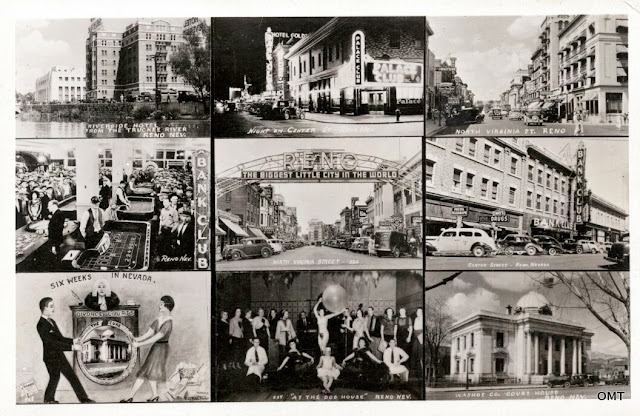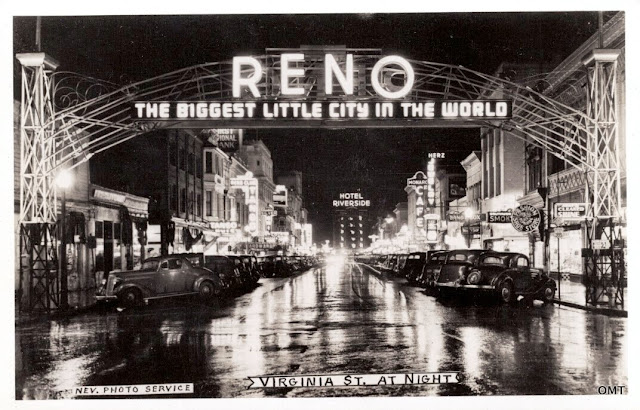Keystone stereographs
and God.
“Many people have
never stopped to wonder why they have two eyes.”
Albert E, Osborne; The
Stereograph and the Stereoscope, 1909
The story of the Keystone View Company really begins with
early rivals Underwood & Underwood. Two brothers in Ottawa, Kansas, Elmer
and Ben Underwood, were only 20 and 18 at the time they set up that company in
1882 but their business plan had foresight. Firstly they would not only produce
stereographs but act as agents for smaller American companies in the region. Within
a few years U&U would be the leading provider of stereographs on the
eastern side of the country. Rather than sell the cards in the usual way, in small sets of
ten or a dozen, they packaged them in boxes of 100 along with the stereoscope. They
understood that customers were willing to pay more for a set of 100 than wait
for the series to be released in small doses. They also used a modern sales
technique we normally associate with bibles and encyclopaedias, door to door, and
for that they needed a small army of travelling salesmen. The brothers were
devout Christians and hired their crew on the understanding they dressed well,
did not smoke or drink and attended church every Sunday. For the Underwoods,
stereographs were not just pretty pictures in 3D; they were morally improving. Show
people scenes of Yosemite Park or New York’s architecture and they would be
moved by the works of God and man. One category the company specialized in was
biblical lands. Using its stereographs, Sunday school and other teachers could
educate children about the Bible. With a scene of a side street in old
Jerusalem the students could see where and how Jesus lived.
Underwood & Underwood was successful but they entered
the scene as the stereograph began to decline in popularity. The reasons for
this probably have more to do with people tiring of the novelty rather than any
threat from alternative technology. The company’s sales techniques and their
religious fervour re-energized the market and they were smart enough to buy up
the stock of companies that were folding. Still, by the turn of the century the
brothers had diversified and were becoming less interested in stereographs.
Enter former U&U travelling salesman B. L Singley. He
had started a small and undistinguished company called Keystone View that
struggled along until the Spanish American War, when President McKinley
encouraged companies to go south and send back propaganda. By the first decade
of the 20th century Keystone was strong enough to challenge U&U’s
dominance and in 1912 it bought the U&U archive, which was itself a
collection of other archives. Though there were a few companies still producing
stereographs. Singley had a virtual monopoly in the U.S.
A good account of the business of stereographs is found in
Anthony W. Lee’s A Shoemaker’s Story
(2008). Ostensibly about the interaction between Quebecois and Chinese and
workers’ resistance in a Massachusetts town in the 1870s, it takes a diversion
into the story of the Kilburn brothers, then significant publishers of
stereographs. Though Benjamin Kilburn was a photographer the company began
buying images from studios or sourced them from collections and built up a
library of American images. He takes the credit for the idea of buying images
then selling stereographs in boxed sets through door to door salesmen. Lee is
good as describing how the Kilburns’ nard-nosed attitude to business and sharp
sense of what the customers needed, rather than just wanted, set a template for
others.
Although U&U frequently credited the photographer this
was unusual. Most companies including Keystone rarely bothered. We know this
photograph was taken by Wisconsin photographer H. H Bennett in 1886, not
because Keystone tells us but because Bennett was significant enough to have
his work held in Wisconsin archives and it can be traced. Other times the only
way to know the photographer’s name is if their image appeared in an earlier
series by U&U or another company and had been recorded. Even that can be
uncertain. Some scenes had a natural vantage point for the camera so on the
same day two photographers could take near identical shots. Likewise copyright
dates refer to publishing, not necessarily when the photograph was taken. This
is particularly relevant to Keystone because by the 1920s, when it was
effectively the only company in America publishing stereographs, it used stock
negatives that could have been taken in the 1860s.
A case in point is this and the other image from Russia. On
the back of both are references to the Communist revolution (it was rare for
Keystone to make explicit political comments though it would always make an
exception for the Soviets). Both look decidedly 19th century and
could well have been taken pre-revolution. Following the revolution, Russia
wasn’t exactly cut off but travel was difficult and in some parts still
dangerous, so if the company wanted Russian scenes it was likely to look
through its stock rather than send someone out or try and buy some from Russian
agencies.
Singley may not have shared the Underwood brothers religious
zeal but along with the negatives Keystone inherited the U&U philosophy
that stereographs were best thought of as didactic tools. On the back of the
cards was a short essay giving a brief history and geography of the place and
an introduction to the culture. In a lot of ways the company’s approach
mirrored that of National Geographic,
which had begun publication in 1888. Both considered their photographs
objective studies, anthropology for the masses, and who could fault an
organization that only wanted to educate people? The problem was that to
express that idea they paradoxically had to make foreign lands look as exotic
as possible. Take this scene from Hungary: the shepherd’s life however was
“characteristic of the Tartar nomads who were (his) ancestors … They have no
dwellings.” in the 1920s, when it was published, Budapest was a centre of
contemporary European intellectual culture. The shepherd may not have cared
much about modern art but not only did he have a house he could well have
driven out to his flock in a car.
Or take this scene of a Czechoslovakian village. Clearly the
scene was carefully arranged by the photographer, down to getting the boy on
the left to look towards something off camera. We can’t be too sure how the
original photo came about; Keystone could have bought rights to an existing
image or sent someone out to find a scene. Whatever happened, it was taken
without awareness of the text that would accompany it. “Almost entirely an
agricultural people, the Slovakians are an untrained, uneducated nation who
chose illiteracy in preference to Hungarian education”. Forget Slovakian Ján Bahýľ, who
built the first motor driven helicopter, wireless inventor Jozef Murgaš or some
300 years of classical composers’ those kind of details might have obliged
Keystone to explain to its viewers that they were actually looking at the
effects of economic deprivation.
In 1909 Underwood & Underwood commissioned Albert E.
Osborne to write The Stereograph and the
Stereoscope. Like any book with the subtitle, What they mean for individual development. What they promise for the
spread of civilization, it has dated, but it casts light on the thinking of
U&U and Keystone. The central argument is that in itself the act of looking
at beauty is moral improvement. To make his point Osborne had to define his
terms; beauty, image and reality, which he did in a very early 19th
century way, but his grounds became shakier when he tried to persuade us that
the stereograph was even better than the real thing. “The farther an object is
away from us the more air we have to look through in seeing it”. Most decent
scientists would say that it is light not atmosphere that disturbs vision -
unless you are in a fog – but that would have spoiled Osborne’s real argument. Because
the stereograph rendered the world more accurately in images than any other
process it was the best means for viewing the world and all its wonders. Because
it removed the flaws of natural vision, ultimately it drew us closer to God.
 |
| WONDERFUL WORLD |

































